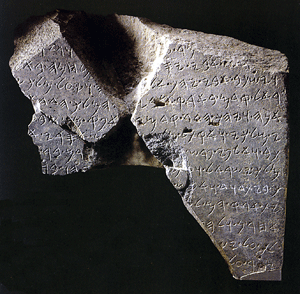
ore than a quarter of a century of archaeology excavations at Tel Dan in the north of Israel at the foot of Mount Hermon produced little in the way of written material. The excavations have been directed through the years since 1966 by Dr. Avraham Biran, distinguised Israeli archaeologist.
Then on July 21, 1993, while work crews were preparing the site for visitors, a broken fragment of basalt stone was uncovered in secondary use in a wall. Surveyor Gila Cook glanced at the stone in the rays of the afternoon sun and saw what looked like alphabetic letters. On closer examination it turned out that, indeed, they had found an inscribed stone..
The discovery was of a fragment of a large monumental inscription, measuring about 32 cm. high and 22 cm. at its greatest width. Apparently the stone had been purposely broken in antiquity. It turned out that the stele fragment mentions King David's dynasty, "the House of David." As the preparatory work for tourism proceeded, two additional fragments of the stele were recovered in two separate, disparate locations in June of 1994. The partially reconstructed text reads as follows:
1. [ ... ...] and cut [ ... ]
2. [ ... ] my father went up [against him when] he fought at [ ... ]
3. And my father lay down, he went to his [ancestors]. And the king of I [s-]
4. rael entered previously in my father's land. [And] Hadad made me king.
5. And Hadad went in front of me, [and] I departed from [the] seven [ ...-]
6. s of my kingdom, and I slew [seve]nty kin[gs], who harnessed thou[sands of cha-]
7. Riots and thousands of horsemen (or: horses). [I killed Jeho]ram son of [Ahab]
8. king of Israel, and [I] killed [Ahaz]iahu son of [Jehoram kin-]
9. g of the House of David. And I set [their towns into ruins and turned]
10. their land into [desolation ... ]
11. other [ ... and Jehu ru-]
12. led over Is[rael ... and I laid ]
13. siege upon [ ... ]
The pavement and the wall where the fragments were found was laid at the end of the 9th or beginning of the 8th century BC, according to pottery fragments recovered in probes beneath the flagstone pavement. Since the fragment and the entire pavement was covered by the debris of the Assyrian destruction of Tiglath Pileser III, in 732 BC, it could not have been laid latter than that year.
The surmise is that Jehoash (798-782), grandson of Jehu, or Jehoash's son, Jeroboam II (793, co-regent 782-753), and more likely Jehoash, was the monarch who had this reminder of Aramaean domination smashed (2 Kgs 13:25). It is further assumed that Hazael (844/42-798?) was then king of Aram- Damascus, because Hazael fought against Jehoram of Israel and Ahaziah of Judah ( 2 Kgs 8:7-15, 28; 2 Chr 22:5). Hazael was followed by his son and successor, Ben-hadad III, early in the 8th century BC
The discovery provides an archaeological connection to the biblical references to the ruling dynasty established by King David approximately two centuries before the events that are mentioned in the inscription. It is the first mention of King David and the earliest mention of a biblical figure outside of the Bible. The discovery is of particular importance in the face of those scholars who were either skeptical or denied the historical existence of King David
For more interesting topics related to archaeology, visit archaeology excavations.
No comments:
Post a Comment